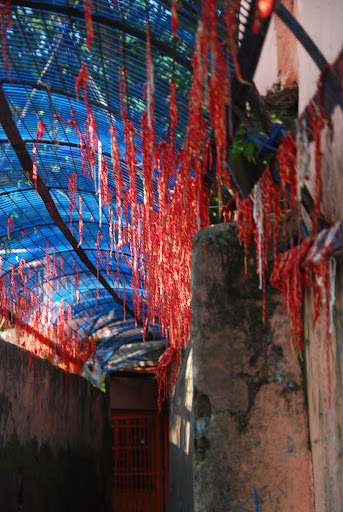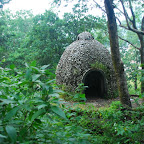
By Nicole
Motioning toward his right, the French guy proclaimed, “I sink zis is zee path!” I cocked my head to look and saw no breaks in the continuous brush. Unconvinced but hopeful, I looked toward Allan, waiting for his internal compass to steady. After a brief pause, he said, “I’m not so sure.”
The memory of a Discovery Channel show, “Survive!” cleared my mind of useless clutter. Though it’d been years since I’d seen it, its captivating nature had kept me up until 3AM and few, if any, of its numerous survival techniques had been lost on me. After all, “a little preparation and the ability to stay calm is all that stands between you and survival,” or so the show purported. Prepared to lead our group, consisting of Allan, myself, our new French friend and our new German friend, to a glorious safety, I carefully reviewed the invaluable lessons learned.
Shit, I thought. Though a quality program it had been--every dramatization was like its own miniseries!--the focus had been on how to survive in climates far colder and at much lower altitudes than our current situation found us.
Shit, I reiterated internally. We’re lost in the Himalayas!
The three guys looked rather calm considering my revelation, so I thought it best to keep a cool exterior myself. Meanwhile, I damned each one of them for having chosen to take a different way down than we had up--namely the way without an obvious trail because, “it’ll be great!” and “that guy said the views will be so much better!”
“That guy” probably knew the way down.
The journey up had taken us five hours, so I figured the way down would be about the same, since the increased speed enjoyed due to the decline would be obviously counterbalanced by the time added due to being lost. I looked to the sun to calculate the amount of time that it planned on lighting our way but in the mountains its position can be deceiving and it was. So I asked Allan what time it was.
“2:30PM,” he said, after looking at his iPhone. (And for those wondering, the GPS function is basically useless, but yes, we were carrying an iPhone.)
I heard the guys start to discuss the frightening possibility of having to spend the night stating, “I have matches” and “we can definitely build a fire.”
Shelter and heat are good and well, but the rhythmic rumblings of my stomach indicated a more emergent need. I opted to eat Gwen, the French guy, first. I reasoned that my gender (being distinct from that of the rest of the group) would give me an automatic pass. And anyway, all Gwen’s years of eating delicious French croissants should be put to sound purpose!

Before I could further orchestrate the logistics of my next meal, I started to feel a burning sensation on my left calf, then my right shoulder, and then on both ankles. “What the hell?” I said.
“It’s nestle,” said Philip, the German guy. “We have this all over Germany. It’s not poisonous, but it’ll burn for a while.”
“Yes, ve have zis in France, as vell,” Gwen remarked.
I am neither sure what exactly Nestle is nor how it’s spelled, because I very well might have misunderstood due to differing accents. But imagine a pricker bush who has, against all convention, fallen in love with a beautiful worker bee. Their sweet-as-honey-passion soon tires, but only after their Nestle offspring has been born, and with it, a most formidable invasive species. Anyway, it hurts, like hell.
We came down over a large boulder to find that there was still no verifiable path. Instead, we found Nestle, and a lot of it. Our international powers combined, we decided we must forge our own path and essentially, conquer the Nestle. (How Western of us all, right?) So with the tiniest of tiny scissors from a Swiss Army knife, Allan began to slowly--it was truly painfully slow, both due to the speed at which it occurred, and also the resultant pain which we still were essentially helpless to avoid--snip away at the Nestle bushes, which stood both higher and wider than each of use (except perhaps, for the Frenchman, but I have already discussed his extraordinary size and presence).
Allan, with both the steadiness of a highly skilled neurosurgeon and the vengeance and might of a ruthless warrior snipped and snipped and snipped. Meanwhile, Gwen, always optimistic and animated, cheered him on, “Zat’s it! Zat’s it.”
Reminded of a quote I read shortly before coming to India about how (to paraphrase and inadequately reference) when traveling, one learns more about the person they travel with than about the place in which the traveling occurs (Special Topics in Calamity Physics), I thought, Al is really good at snipping Nestle. And the note to self which followed: he’s a keeper.

And shortly thereafter, we emerged from the brambles of nestle, into what I imagined to be the promise land, which was actually an eerily desolate settlement of shelters for herders. Idyllic, yes. Useful in this particular instance, no.
And with the irony that seems to be a recurrent theme on this trip, I saw a small sign with English lettering: Wellcome!
And welcome to you as well!
Just past the pseudovillage, my wish was granted, only instead of finding just one path, there were an overwhelming number of paths, leading in every direction possible.
This moment prompted a vow (after all, literary flair must be generated in some way!) Never, I vowed, never again will I watch the Discovery Channel or any of its subsidiaries--a gesture of symbolic opposition to the inadequate and grossly incomplete survival shows presented through their programming. Feeling righteous, I scanned my environment. The view prompted in me an overwhelming, if unusual, peace. The notion of control, as illusory as my heightened sense of self, tumbled like a rock down the mountain, hitting larger rocks on its way down, and even breaking into smaller pieces. My expression must have exhibited some combination of calm and inquiry, and I felt Allan’s hand on my shoulder. “We’re not lost,” he said.
“No, we’re not lost,” I agreed.
And just as I prepared to metaphorically extend my hand to make amends with this Lostness, I heard Philip say something excitedly.
“What?” I asked.
“Goats,” he said. “I see goats.”
Sometimes goats mean milk, other times meat. This time, it meant something much more satiating: a herder!
With a predictable hop in our step, we moved through the long line of goats. I considered kissing a few but my soon-to-be-vet-student sister has frightened me with tales of zoonotic diseases, so I kind of curtsied instead. Strange, I know, but my thoughts of self-grandeur almost always involve me as a famous ballet dancer, save the disfigured feet and propensity for eating disorders.
After zigzagging through a fair number of goats, we found their shepard. How poetic!
We inquired about “the way” and named the village from which we departed; though we did so (by necessity) in English, an obvious disadvantage for this old Tibetan man.
With hands which bore a quality of leather and a testament to the nomadic lifestyle of yesteryear that continues to guide him along his own path, he motioned in a general direction and said, “Down, down.”

Vague though the directions might have been, they were affirmation of our journey--one that has been taken by so many others, in much more desperate circumstances. In that moment, I felt love for that shepard.
And so, we made our great descent and eventually made our way to the waterfall with which we were all familiar. It just sort of happened. We just sort of made our way back, because in India, there’s no such thing as the wrong way, per se. There’s just a series of alternate routes. And finally, we made it ‘home.’
Allan's addendum: The GPS on the phone does work. But it does not offer turn by turn directions in the Himalayas. Below is a map of part of the hike.
View Triund in a larger map 




























